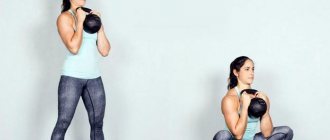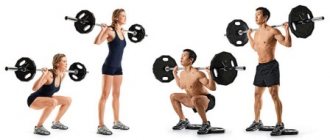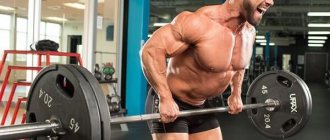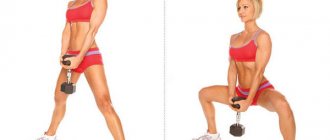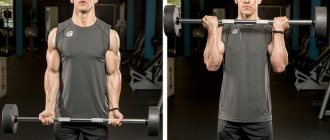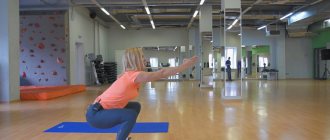Explosive dynamic jump squats for impact work on the thigh muscles.
Explosion is one of the basic elements of interval training. Dynamic squats rely on muscle tension and explosive spring energy. This makes it possible to use subcutaneous fat in an emergency mode and effectively load the muscles.
Spread your legs wide, sumo style
This position of setting your legs wide with your hands touching the floor makes it possible to tighten your muscles before jumping up. This gives maximum explosive load.
Jump up like a rocket
At the moment of jumping, you need to connect your legs together.
Land with your feet together
Connecting the legs allows you to slightly reduce tension and relax the muscles in order to carry out a jumping movement with the legs moving to the sides.
Jump back to the starting point
Returning by jumping to the starting position allows you to load the outer side of the leg muscles with a powerful energy blow. At this moment, the buttocks also tense, which of course benefits them. This exercise feels similar to jumping jacks.
When the basic exercises are fully mastered, the task arises of increasing the load on the muscles. And to do this you need to either increase the weights, or add the number of repetitions, or speed up.
Few people know that this problem is easily solved by dynamic squats, which, unlike regular ones, will make you sweat and involve not only the quadriceps and buttocks, but also almost all the muscles of the body. Is that possible? Quite!
side lunge with slide
3 sets 1 minute
Stand straight, legs together, feet parallel to each other. Stretch your arms forward and slightly to the sides. Place your right foot on a small towel. Shift your body weight to your left leg, bend it at the knee at an angle of 90 degrees, while slowly (in four counts) move your right leg to the side, sliding on the towel. Also slowly return to the starting position, straightening your left leg. Perform the movement for 30 seconds, then switch sides and do the same.
Dynamic squats
Squat chart for a month
| Day | Quantity | Day | Quantity | Day | Quantity |
| 1 | 60 | 11 | 90 | 21 | 150 |
| 2 | 60 | 12 | Rest | 22 | 150 |
| 3 | 60 | 13 | 102 | 23 | 150 |
| 4 | Rest | 14 | 102 | 24 | Rest |
| 5 | 72 | 15 | 102 | 25 | 180 |
| 6 | 72 | 16 | Rest | 26 | 180 |
| 7 | 72 | 17 | 120 | 27 | 180 |
| 8 | Rest | 18 | 120 | 28 | Rest |
| 9 | 90 | 19 | 120 | 29 | 210 |
| 10 | 90 | 20 | Rest | 30 | 210 |
Squats and leg raises
3 sets 10 reps
Perform a squat. In the top position, move your leg back. Then repeat the exercise on the other leg. Raising the leg from a standing position allows you to additionally work the back of the thigh, buttocks and abdominal muscles. Remember to keep your back straight while squatting. Don't lean forward when you move your leg back.
Do 3 sets of 10 reps on each leg.
Dynamic squats
Additional: Hand position
The difficulty of squats also depends on the position of the hands. There are several options, I will list them in increasing complexity:
– straight arms extended forward, hands folded. This is the easiest way to maintain balance.
- hands on the belt. Stabilizing muscles are included in the work.
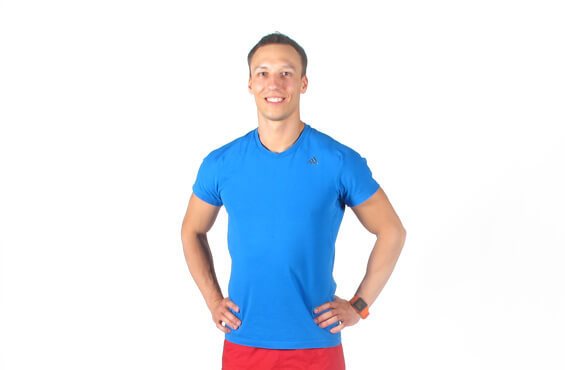
– arms crossed on shoulders. Less counterweight means more work for the stabilizer muscles.
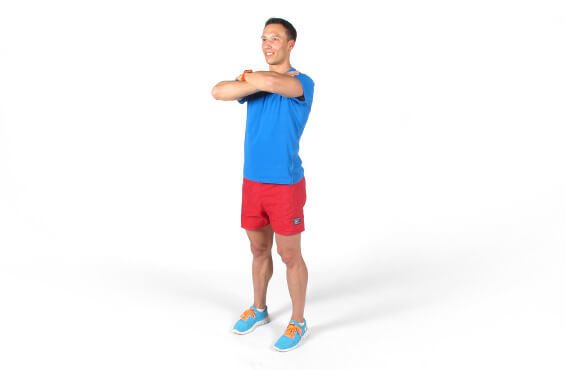
– hands behind your head, elbows to the sides. The load on the heart increases and the muscles that control posture work (you need to make sure that your elbows are constantly spread out to the sides).
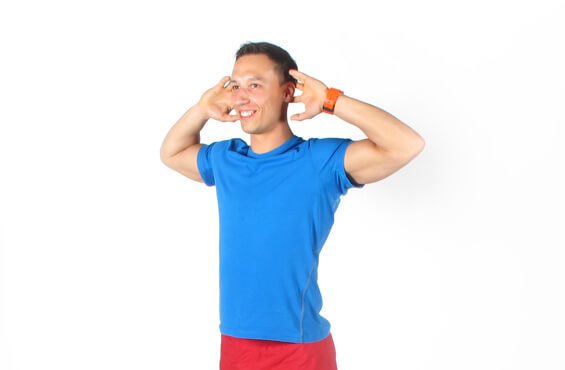
– straight arms pointing upward. The load on the back extensor muscles, upper shoulder girdle and heart increases. published by econet.ru.
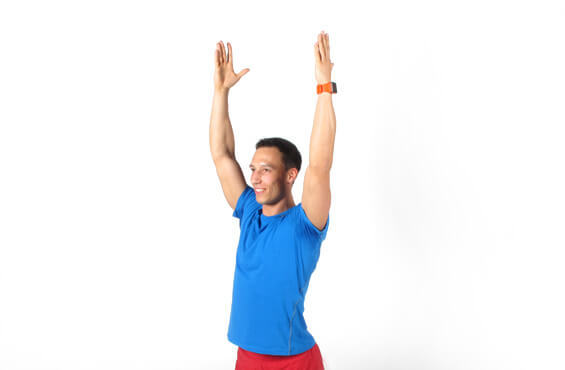
PS And remember, just by changing your consciousness, we are changing the world together! © econet
Did you like the article? Write your opinion in the comments. Subscribe to our FB:
Sumo + kick
3 sets 8 reps
When the basic exercises are fully mastered, the task arises of increasing the load on the muscles. And to do this you need to either increase the weights, or add the number of repetitions, or speed up.
Few people know that this problem is easily solved by dynamic squats, which, unlike regular ones, will make you sweat and involve not only the quadriceps and buttocks, but also almost all the muscles of the body. Is that possible? Quite!
What muscles are used when squatting?
Squats work the largest muscle group – the legs. In addition, the exercise strengthens joints, ligaments and tendons, making them stronger and more resilient. In addition to the muscles, the ankle, hip and knee joints take part in the work.
What muscles are involved in squats? Let’s look in more detail at which muscle groups are tensed:
- Buttocks – gluteus maximus muscles;
- Quadriceps – front of the thigh;
- Biceps femoris - the back of the thigh.
Also, during the work, many stabilizer muscles and the lower back are involved.
What it is?
First you need to understand what dynamic squats are and how they differ from.
Firstly, they are characterized by a fast pace, i.e. if you are used to slowly descending to the lowest point and just as slowly rising from it, here such a rhythm is extremely undesirable. Everything is done quickly, with the help of pushes and jerks.
Secondly, now no part of your body will remain static. This means that you will have to move both your arms and legs.
Outwardly, it looks like jumping from the bottom of a squat with your feet off the ground. Hence the work of all parts of the body. But the main load still falls on the quadriceps.
Benefit
Dynamic squats improve your mood and give you energy throughout the day. They are useful for both men (in terms of pumping muscle structure) and women (in terms of losing weight).
As a result of regular and intense training, the following miracles happen to the body:
- muscle mass increases;
- toned shapes appear;
- metabolism improves;
- calories are actively burned;
- excess weight goes away;
- the condition of the respiratory and cardiovascular systems improves;
- the musculoskeletal system develops, thanks to the elimination and prevention of congestion;
- joint function improves.
Agree: such miracles are worthy of mastering the technique of such squats and actively including them in your training programs for losing weight or building muscles.
How many approaches should you do?
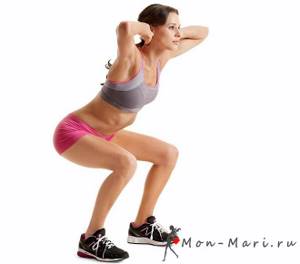
The duration of the exercise, as well as the number of approaches required, largely depends on the goals you are trying to achieve. It is worth taking into account your diet, which determines the subsequent results of your training. When the body receives enough calories, systematic exercise allows you to build muscle mass. To do this, you should pay attention to the foods you eat during the day. If you just want to get rid of excess fat on the buttocks and thighs, combine going to the gym with appropriate diets, but do not overdo it, since the body requires enough food to perform the necessary tasks.
To lose weight, you should repeat the exercise many times, using a small additional weight. For beginners, it is best to pick up dumbbells, and as you gradually get used to the weight, increase the weight of the load.
In order to properly pump up, use more weight with fewer squats. Pay attention to the technique of performing the exercise for weight loss, and also try to leave a small reserve of strength with you before completing the current approach.
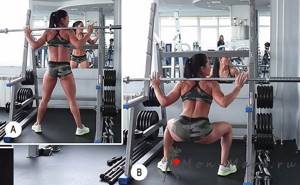
Execution technique
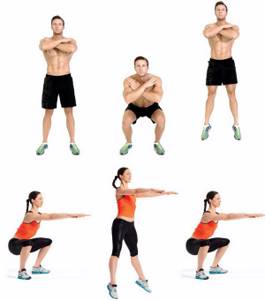
If these squats interest you, get acquainted with the technique of performing them. She will tell you in detail how to do such exercises correctly. Conventionally, they can be divided into 4 parts, and each of them requires careful study.
Initial position
- Place your feet shoulder-width apart.
- Spread your socks slightly to the sides.
- Keep your back straight all the time.
- The arms can have different positions: they can be crossed on the chest, placed behind the head in a lock, placed on the shoulders or waist. Here, choose the option that is convenient for you.
- Look forward. We don't look at our feet.
If dynamic squats are performed with a barbell, in the starting position the apparatus is placed on the trapezius and tightly squeezed with the palms. But then keep in mind that the arms will be static throughout the entire approach.
The same goes for exercises with dumbbells. They will also be only partially dynamic, because you can’t wave your hands, which will hold heavy projectiles. The dumbbells should be pointed straight down. Rocking them from side to side can injure your shoulder.
Bottom of squat
- Take a deep breath.
- Execute (parallel is not considered dynamic).
- At the same time, keep your back straight, do not round the sacral area.
- Feel your thigh touching your calf muscles.
- Fix at this lowest point for 1-2 seconds.
Bounce
- Make an explosive, fairly sharp upward movement.
- In this case, you need to try to quickly straighten your legs.
- Exhale sharply through your mouth.
- Lift your legs off the ground due to powerful acceleration by 10-30 cm.
- When jumping, you can spread your legs to the sides - this way you will get an additional stretch for the leg muscles.
- In this case, you can raise your arms up above your head, spread them to the sides, or make a clap with them.
If you are performing a squat with weights, you need to carefully monitor the position of the projectiles during the jump. If you feel that you are outweighed and cannot control your movements, you need to either reduce the working weight or do the exercise with your own weight.
Landing
- While lowering, take a deep breath again.
- You need to land on slightly bent legs.
- Without stopping, continue moving down.
- When landing, descend as deeply as possible again.
- You can touch the floor with your fingers, but you must be careful not to hit them on the ground.
After this, you need to repeat all parts of the dynamic squat again. The work must be continuous to keep the muscles under constant tension. The most important period described is landing, since it is at this moment that the risk of injury to the knee joint increases. To avoid it, you need to spring and land on bent knees.

Dynamic squats are a very effective and at the same time traumatic exercise. Therefore, here you need to clearly practice all the execution techniques from start to finish. In addition, carefully listen to the advice of experts. Every nuance is important and works for the result and preservation of your health.
It is imperative to observe contraindications due to the too high intensity and speed of the exercise. These include:
- joint injuries;
- sore back;
- problems with the spine;
- diseases of the cardiovascular system;
- obesity.
- Dynamic squats fit perfectly into fat-burning training and CrossFit.
- Breathe correctly: squat as you inhale, jump out as you exhale.
- Recommended training regimen: daily, if without weights, every other day - with a barbell or dumbbells.
- Do 3-5 sets of 10-15 squats, gradually increasing the number of repetitions.
- The interval between sets is no more than 2 minutes.
- If after training you experience the slightest pain in your joints or back, review your squat technique, eliminate mistakes, lighten the load, or move on to another type of exercise.
Few people use dynamic squats in their training programs. As you just saw, they are very useful for the body, for weight loss, and for CrossFit. The technique, despite the intensity and amplitude, is easy to learn.
As soon as you have worked out all the basic exercises and it’s time to complicate them, be sure to adopt this type of squats. They will give you a boost of energy for the whole day and allow you to shape your figure.
From Dr. Mercola
If you want a way to measurably improve your fitness and achieve serious training results - quickly
– you should stop doing squat exercises.
This is the one exercise that should be included in every workout program because squats are easy to do and don't require
additional equipment, and you can squat almost anywhere.
More importantly, although squats are often thought of as a leg exercise, they actually benefit your entire body, including your core...
The benefits of squats without weight
You can often hear the following question: how are squats without weight effective? Is it worth doing them at all? If muscles grow from weights. After all, you can achieve tone only by working with heavy weights.
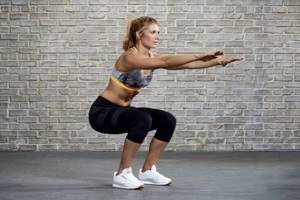
But, in fact, this is not entirely true. Yes, to perform in competitions you need to work a lot and persistently with weights. But in order to give your muscles shape and tone, squats without weight are enough.
Our body does not have a “sensor” for determining weight. It is important not how much weight you lift, but how much the body is under load, so even with regular squats you can achieve results. Naturally, it will not be outstanding, but when working with your own weight, you can tighten your legs and buttocks well.
- Therefore, answering the question, is there any sense in this exercise, then yes:
- In addition to muscles, the hip and knee joints are involved in the work, balance is developed, they can be done absolutely anywhere - on the street, at home, at work, in the gym, etc.
- For women, air squats are useful because they have a fat-burning effect, increase endurance, and strengthen the buttocks and thighs.
Bodyweight squats are an essential part of the warm-up for any sport. Doing them will allow you to warm up and work out large joints and ligaments. Thereby preparing the body and organism for the exercise.
By including it in your training program, you can count on the following positive effects:
- Improves the functioning of the cardiovascular system. This increases tone and endurance, and has a positive effect on heart contractions. Due to improved blood flow, nutrients and vitamins travel faster to muscles and joints, and the feeling of comfort also increases, and limbs stop freezing, which is important in the winter season. It is important to perform the exercise at a moderate pace.
- Work on balance and coordination. Squats are great for developing basic coordination skills. At first, to improve your balance, you can put your hands forward. With subsequent mastery of the technique, they can be omitted.
- Increased muscle tone in the legs and lower back. Squats involve almost all leg muscles. They tone the buttocks, quadriceps and hamstrings. At the same time, the stabilizer muscles that hold the body are included in the work.
- Strengthening joints and ligaments. This leads to improved flexibility, the ability of joints and ligaments to support the weight of their own body. Serves as a good preventive measure to protect against injury and the use of higher weights in squats.
- Safely practicing the correct technique. The absence of weights makes it possible to work out the technique of performing the exercise in the smallest detail. There are no risks or health hazards. Incorrect position of the lower back and knees is a mistake many beginners make. And it is better if it is corrected when working with your own weight than with weights.
Therefore, based on all of the above, it can be noted that even ordinary squats without weights have their own effect. At a minimum, they should definitely be included in the warm-up, and in the case of beginners, they are an excellent option for practicing squat technique.
How to do squats correctly?
Squats have long been criticized for their negative effects on the knees, but research has shown that when performed correctly, squats can actually improve knee joint health and strengthen connective tissue.
- Warm-up
- Stand straight with your feet shoulder-width apart or slightly wider
- Your back should be kept straight and your knees should be level with your feet.
- Slowly bend your knees, hips, and ankles, lowering yourself until you reach a 90-degree angle between your hips and ankles.
Dynamic exercises
– these are all exercises and types of load in fitness that are associated with an abundance of movements, actions, movement in space of the entire body and its individual parts. From Greek “dynamikos” is translated as “strong”. Dynamic exercises lead to the development of strength and increased muscle length.
Walking, running, jumping, swimming, cycling, dancing, squats, push-ups, machine exercises, dumbbell presses, arm and leg swings, torso bends, and so on and so forth are all examples of dynamic exercises.
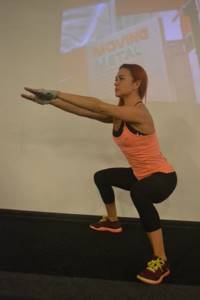
Dynamic squat

Static wall squat variation
Dynamic push-up
Static work: plank
Work in statics: exercise “corner”
How to learn to squat correctly?
Before starting the exercise, it is recommended to warm up well. It is imperative to warm up your legs, in particular your knee and hip joints.
It wouldn’t be a bad idea to do cardio before squats, when the muscles are already quite well warmed up and prepared for intense work.
The squatting technique itself is not complicated. The most important thing is to practice all the elements of the movement, not to rush anywhere and take your time. And if squats without weight can forgive certain technical errors, then when performing them with weights, there is a high probability of injury.
Let's look at how to do squats correctly:
- Starting position: place your feet shoulder-width apart, and for greater stability and maximum inclusion of the gluteal muscles in the work, you can place them a little wider. The knees and feet are located on the same vertical line. For greater stability, the feet can be slightly turned to the side. The back is straight, the chest and shoulders are straightened, the gaze is directed forward, the back is arched at the lower back. Your arms can be placed forward to maintain balance or spread to the sides.
- As you exhale: maintaining the position of the body, due to the movement of the hip joint, we begin to lower ourselves down until an angle of 90 degrees is formed in the knees and the thighs are parallel to the floor. If flexibility allows or there is a desire to maximally load the gluteal muscles, then you can squat deeper than parallel.
- While inhaling: without stopping at the bottom, we return to the starting position.
Beginners can start with 15-20 repetitions and gradually increase this number. It is very important to rely not on the number of approaches and repetitions, but on the correct technique of air squats.
The movement of squats is similar to simulating sitting on a chair or bench. To make this easier, use a real chair or bench. Lower yourself down until you sit on it, and then use your legs to lift yourself up. This will help you thoroughly master the anatomy of squats from scratch.
Advantages
Dynamic exercises are a very popular type of physical activity, present in almost all types of club fitness and individual home training. Dynamic practices are attractive due to the following advantages:
- they actively burn fat and promote weight loss;
- they significantly increase muscle tone and make the body sculpted;
- they train the heart muscle and have a beneficial effect on the respiratory system;
- they put a load on the musculoskeletal system, thereby preventing the emergence and development of congestion in it;
- they perfectly relieve fatigue, allow you to switch from worries to a positive wave, and get a portion of energy for new achievements;
- The variety of forms of dynamic load allows you to choose useful exercises for yourself at any age and for any medical contraindications.
Flaws
- Some types of dynamic exercise may be contraindicated for diseases of the musculoskeletal system and cardiovascular system.
- Certain types of dynamic exercises (running, leg swings, jumping, etc.) require a lot of space to perform and are not suitable for home training.
- For better motivation in order to make the training process more varied and effective for performing dynamic exercises, additional equipment may be needed (simulators, horizontal bar, weights, etc.)
As you can see, by and large, dynamic exercises have no disadvantages. In the absence of contraindications and a small amount of free time, a reasonably selected dynamic load can always and everywhere bring benefits to health, appearance and emotional state. And if, for example, there is not enough space at home to perform the same leg swings, then high-amplitude movements can always be separated into a separate block and performed in the fresh air (in a park, stadium, etc.). If your city does not have a swimming pool, you can go swimming in open water. If you feel that CrossFit is too intense for your heart, stop walking. In short, you can always adapt to individual characteristics and choose the appropriate type of dynamic load.
The difference between dynamic exercises and static ones
The main difference between static and dynamic exercises is that static exercises exclude movement. “Static” means at rest, without movement. Static exercises involve fixing a certain position in space and holding it for a certain time (a few seconds, half a minute, several minutes, etc.)
By and large, many popular exercises can be performed both dynamically and statically.
For example, the popular squat exercise can be performed in the traditional dynamic way: squat and straighten. But there is a static version of it, when you lean your back against the wall, lower yourself to the bottom position and fix this position.
The popular push-up exercise can be performed in the traditional dynamic way: while in a plank position, bend your elbows and straighten them. Or you can fix this very bar and work in this way in statics.
The popular twisting exercise can be performed in a dynamic way: from a position lying with your back on the floor, you raise your body and return to the starting position. Or you can take the so-called “corner” position (raised body + straight legs raised above the floor) and hold it statically.
Both dynamic and static exercises are useful, but not for everyone and not to the same extent. Beginners in fitness are advised to focus on dynamic loads, since static loads can harm fragile tendons. Women should make up their training plan 70% of dynamic exercises and 30% of the time to devote to static work. For men, this proportion shifts towards statics, to which it is recommended to devote 40% of the training, and the remaining 60% remains for dynamic load.
(4
ratings, average:
5.00
out of 5)
Every woman dreams of having a beautiful, toned body. It can be obtained through diets and the gym. But before doing this or that exercise, you need to know the technique of doing it. Then the desired result will be achieved.
What mistakes can happen when doing squats?
Squats with your own weight are a basic and common exercise that can be found not only in the gym, but in almost any sports discipline. But despite this, everyone manages to make mistakes. And not just beginners!
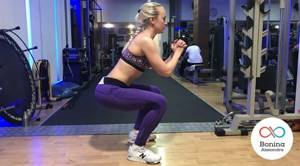
Let's look at the main mistakes to avoid:
- Neglecting warm-up. It is unacceptable to start doing the exercise without warming up the joints, muscles and ligaments. This may cause injury.
- Insufficient squat depth. Of course, the exercise will be easy to perform, but the main load will be received exclusively by the quadriceps. In particular, its upper part. What causes muscle imbalance?
- Knees extend beyond toes when squatting. This must be controlled so as not to lose your balance and fall forward or get injured. With your feet parallel to each other, your knees should be pointing forward. If the toes move to the sides, the knees follow them.
- Incorrect foot placement. If you place your legs too narrow, it will be impossible to squat down to parallel with the floor. With your feet wide, there is a risk of falling backwards. Therefore, it is very important to find and choose the optimal foot placement for yourself.
- Violation of the initial position of the body. This could be a rounded back, drooping shoulders, etc. It is very important to maintain the original position of the body throughout the entire exercise. Spinal tension should be maintained by toning the buttocks.
Where to begin
Many women dream of having beautiful, firm buttocks. First of all, they are boring in order to attract the attention of men, and only then to amuse their pride. Some people diligently take up sports, buying a subscription to a fitness room, some watch training videos, try to train at home, but for others, their desire remains unfulfilled. It all depends on character and willpower.
Therefore, in order to start exercising, you need to know a few rules that will help you successfully achieve success:
- keep your abs in constant tension;
- the back should be straight;
- the knees should be parallel to the feet (otherwise it will happen);
- do not lift your heels off the floor;
- correct breathing.
You may ask: why keep your abs in constant tension if you need to pump up your buttocks? The answer is very simple. When the abs tense, the whole body tenses. Such physical composure helps maintain the shape of not only the gluteal muscle, but also the abdominal muscles, and this is an additional success (). But this rule must be followed, otherwise you will not achieve the necessary progress.
The second, important rule is to keep your back straight. In this case, the tension goes to the back muscle. This makes the butt round and convex, the back straighter (), more beautiful. With a straight back, squats are more difficult, so the results will be more noticeable. If your back is bent, the training is carried out easily and quickly, then you will not achieve the desired effect. After all, it will be more like tilting rather than lowering.
As for the legs, they should be shoulder-width apart. Knees parallel to feet. At this angle it is better to tense the gluteal muscles. It also tightens your legs, eliminating cellulite. This position of the legs has a positive effect on the entire lower body.
Feet should not leave the floor. This position of the feet has a good effect on the calf and gluteal ligaments. It also covers the entire lower part of the body, bringing it into order. When you lift your feet off the floor, the desired effect does not occur. The tension does not reach the buttock, and therefore does not affect the result in any way.
And proper breathing is the basis of any exercise. Taking a deep breath while lifting and exhaling while squatting will make your exercise a little easier. Most often, people run out of breath precisely because of improper breathing. Even the most resilient people must use proper breathing techniques. It will help you conserve energy and perform exercises calmly.
To perform lowering correctly, you should follow the rules. Then in a short period of time, you will see at least a small result. And to see the result, you will have to work hard for a couple of months. This is not much compared to how happy you will be with the result. But it is worth remembering that you should exercise regularly to achieve the desired effect. It is important to know that in order for your butt not to disappear after two weeks, you need to visit the gym at least twice a week. This is necessary to maintain existing forms.
Exercises for the buttocks
There are several exercises that can be performed both in the gym and squats for the buttocks at home.
Here are some exercises that are useful for girls:
- regular squats;
- plie;
- narrow feet;
- curtsy;
- balance;
- martin.
Proper regular training improves leg muscles and gives them tone. And you need to start by standing straight, feet shoulder-width apart, body tense. Then you need to take a deep breath, move your butt back, and sit down. After you sit down, exhale all the air without lifting your feet off the floor.
Although they take second place after aerobics, they are no less effective. The advantage is that you can do them not only in the gym, but also squats for the buttocks at home are effective. But before you start squats, you should watch training videos - lessons on how to do squats correctly for weight loss. After this, you can safely start doing the exercises.
If you are not lazy, exercising in the morning and evening, you can achieve results within a month. Moreover, the condition is that you do everything correctly, without deviating from the norms.
Types of squats
There are many ways to perform this exercise. Alternate squat variations to target different muscle groups. Squats vary in the location of the center of gravity, depth, placement of the feet, static or dynamic manner of execution.
According to the location of the center of gravity
Squats in many types of sports disciplines are performed with weights (weights, barbells, dumbbells):
- Squats with a barbell on your shoulders. The barbell is located on the upper back (traps). The most productive exercise option. Considered safer than the front squat due to its more stable position. The quadriceps and gluteal muscles work the most. Stabilizers are the hamstrings and spinal extensors.
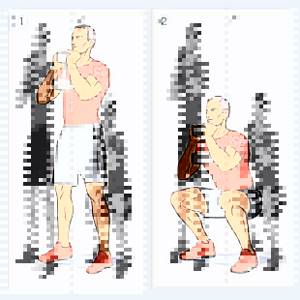
By depth
Different squat depths use different muscles in the legs and back:
- Partial or shallow squats. This type of exercise mainly works only the quadriceps. Most often, it is performed by most beginners and even more experienced athletes, because they cannot or do not want to squat deeper (which is more difficult, although more effective). There is no need to chase weight by doing partial squats, this is traumatic and does not make sense from the point of view of effectiveness in gaining muscle mass.
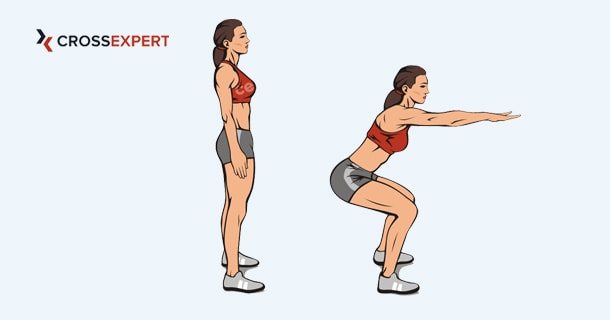
- Squats to parallel. The most common form of squats. The depth of lowering in it is limited to the position in which the thigh is parallel to the floor.
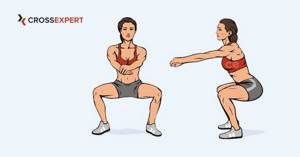
- Deep squats. When performing deep squats, the pelvis drops below the knees. This option is the most traumatic for the knee joint due to the large bend of the knees. This squat creates a lot of stress on the buttocks, so it is often used by girls who want to pump up their butt.
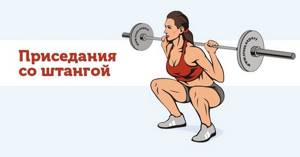
By position of the legs
Depending on the position of the legs, squats are divided into:
- Hack squats. They are performed by lifting the barbell from the floor and holding it behind the back with outstretched arms. There is also a special simulator for this exercise in gyms, which makes it much more convenient to perform it. During the execution, part of the load is transferred from the legs to the back. In the simulator, you can shift the load to the outer thigh by placing your feet shoulder-width apart.
Sources:
https://fitspine.ru/uprazhnenija/bazovye/pravilnye-prisedanija-kak-nauchitsja-delat-vozdushnye-prisedanija-ili-prised-bez-vesa/ https://econet.ru/articles/10-vidov-prisedaniy- tehnika-vypolneniya https://cross.expert/ob-uprazhneniyah/prisedaniya.html
Squats
Squatting with additional weight increases the effectiveness of the exercise by fifty percent. So, more energy and effort are expended than during regular squats. They also give results faster; with their help you can pump up the gluteal muscle. But for this it is worth doing better. To improve it, light, intermittent squats are enough.
In order to start squats with a barbell, you need to warm up thoroughly. For beginners, you should start with an empty bar, so as not to damage your cervical vertebrae or back out of habit. After some time, you should gradually add weight, about ten to fifteen kilograms. Then your buttocks will become as strong as a walnut.
Rules for performing squats using a barbell
To pump up your buttocks with a barbell you need to follow some rules:
- Favorable leg position.
- Do not lift your heels off the floor.
- Low squat.
- Toes should be parallel to your knees.
The legs should be placed depending on what kind of buttocks you want to pump up. If you put your legs in a narrow position, the impact will only occur on the gluteus maximus muscle. If you place them wider, then the entire lower part of the body will swing. You can determine how to place your feet with the help of a trainer. He will advise the best position of the legs and suggest an effective training method.
Just like in a regular squat, you do not need to lift your feet off the floor. If you can’t get into the right position, put something under your feet. This could be a cushion placed under your neck, or a rolled up towel; after working out with the cushion for a while, you will get used to it and be able to do without it.
In order to pump up the buttocks, the squat should be performed low. This results in a greater impact on the muscles. Moreover, additional weight increases the speed of the result. And the correct direction of socks makes it the most effective for weight loss. You can’t use them with a barbell after you’ve pumped up your butt with complex exercises.
What muscles work

The greatest load occurs on the gluteus maximus muscle. It is responsible for elasticity and beauty of forms. After the first workouts, pain may occur when walking. With the help of a little morning warm-up they will pass. If your muscles hurt after training, then the training was a success. You should be happy because you are doing everything right.
There is already less load on the back, inner surface of the thigh. It is there that, under the influence of excess weight, the “orange peel” and flabbiness appear. It's called cellulite. It occurs in both young girls and middle-aged women due to the fact that they do not lead a sufficiently active lifestyle. And training with a barbell eliminates unpleasant consequences, making the skin beautiful, toned, and elastic.
Benefit for health
In addition to losing weight and tightening muscles, squats have other beneficial properties:
- fat turns into muscle tissue;
- strengthens the back;
- the heart is strengthened.
They combine aerobic and strength training, which is very good for the heart. Light exercise strengthens the heart vessels. Also, with their help, fatty tissue disappears on the hips, buttocks, and sides. But in addition to the pleasant transformation of the buttocks, squats affect the back, they become stronger. In the future, this will relieve you of back pain that causes discomfort.
Why do squats without weight?
It would seem that muscles grow from weights and only progression of the load allows you to achieve the desired result in hypertrophy. Yes it is. But before you start squatting with weights, you need to master air squats. This will help you fully master the correct technique and anatomy of squats.
Only after this can you start training with weights. This technique will not only increase the effectiveness of the exercise, but will also avoid injury.
Do you want to improve your figure and health, without harming your spine and joints? Get my free resources on smart fitness at the gym or at home and learn how to exercise the right way!
They are suitable for both beginners and advanced fitness fans.

